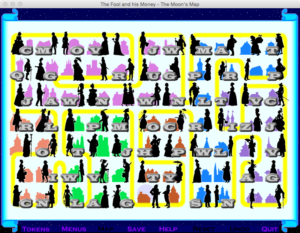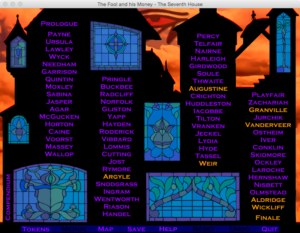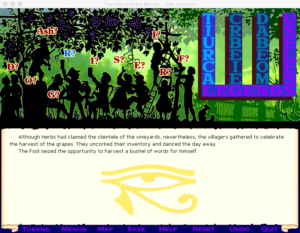Munch’s Oddysee: The End of the Massive Side-Quest
Finally I’m through with the Lulu Fund shenanigans, which turned out to take up the bulk of the game. To recap: Abe and Munch’s plan involves making a low-level Glukkon named Lulu stinking rich. They do this by sneaking into various other Glukkons’ offices, possessing them, and making them give their life savings to Lulu, after which they die from the shock of suddenly being broke. It’s a nasty scheme for a grotesque world. Lulu, as far as I can tell, is oblivious to why everyone is suddenly being so generous with him, but honestly he doesn’t get a lot of screen time, so who knows what he’s thinking? All I can say for sure is that he’s pleased with developments.
The last of the Glukkons you rob is dressed differently from the rest, with a glittery purple cowboy hat and aviator-style sunglasses. He doesn’t act any different — like all the Glukkons, he just stands in his little office waiting to be possessed, repeating the same seven self-aggrandizing barks in a gravelly Brooklyn accent (“I’m at the top of the world”, “How did I get so perfect?”, “I’m going to need an ass the size of a truck to fit this wallet”, etc.) But the outfit makes it clear that he’s a special Glukkon, a boss Glukkon, even if there’s really nothing to distinguish him otherwise. (There may be a lesson in that.) Afterwards, Lulu, with uncontainable joy, wears the same outfit on the flying barge that brings him to Vykkers Labs, the floating fortress that’s been your goal.
It looks like my guess was right: the whole point of the Lulu scheme was to let Abe and Munch sneak back to Vykkers Labs aboard that barge. And that’s where the story stops making sense to me. First of all, this isn’t the first time we’ve been to Vykkers Labs. It’s where Munch started the game. Abe had this whole mission to rescue Munch, and although that didn’t quite go as planned, due to Munch escaping without his help, he did have a considerably simpler way of reaching the Labs back then. Secondly, if Vykkers Labs is where they needed to be, why did the original plan involve leaving at all? Now, Abe’s Oddysee had a similar overall arc. There, Abe escaped from the meat plant, had a series of adventures in the world outside, and then in the end returned to where he escaped from to free the remaining captives and destroy the place. But there, there was a clear reason: Abe didn’t have the ability to finish his task until he visited the ancient temples and received powers from his people’s gods. (Powers which he seems to have lost after the conclusion of that game, by the way.) What did Abe and Munch gain by leaving the Labs before their task was complete? They’re no more powerful than they were when they escaped.
Project Lulu makes sense as game design: it provides an excuse for an arbitrary series of levels that don’t advance the story individually. But I don’t know that it makes sense as plot.
 Comments(1)
Comments(1)

